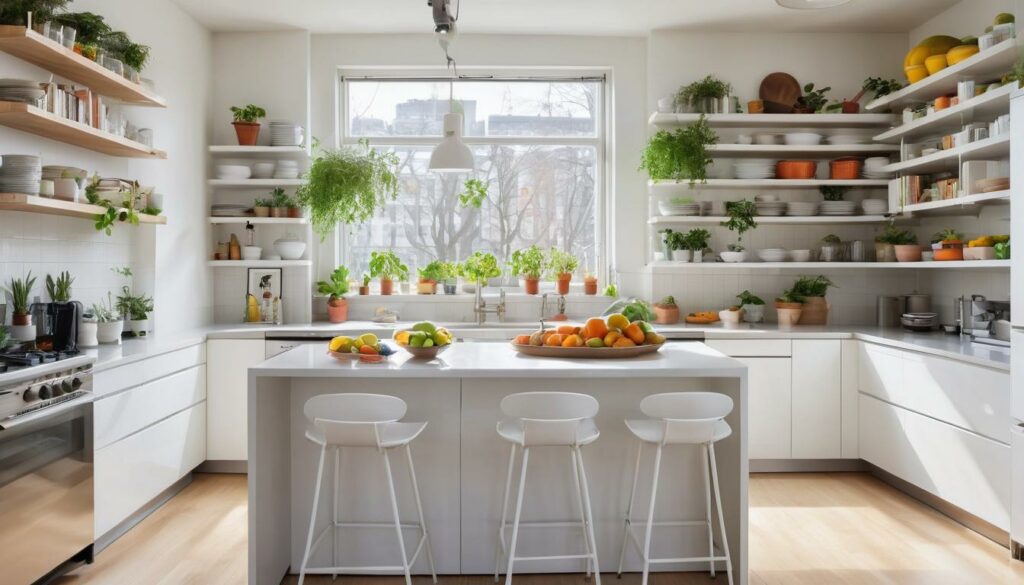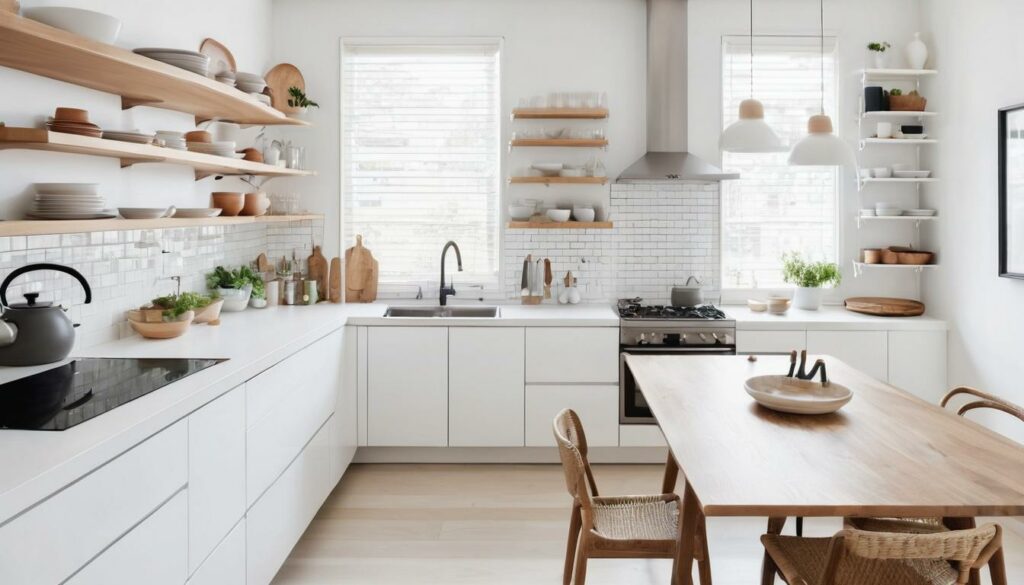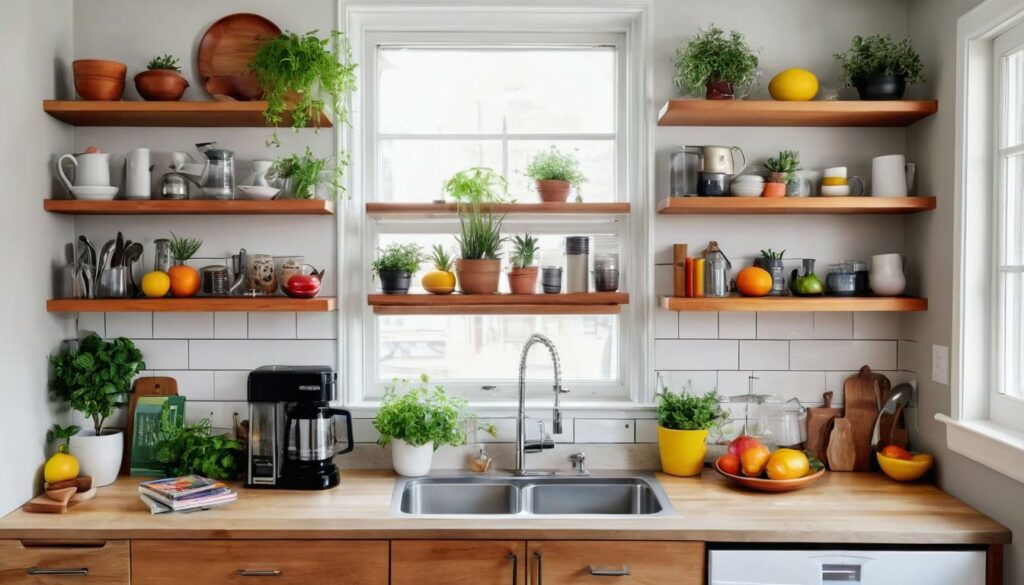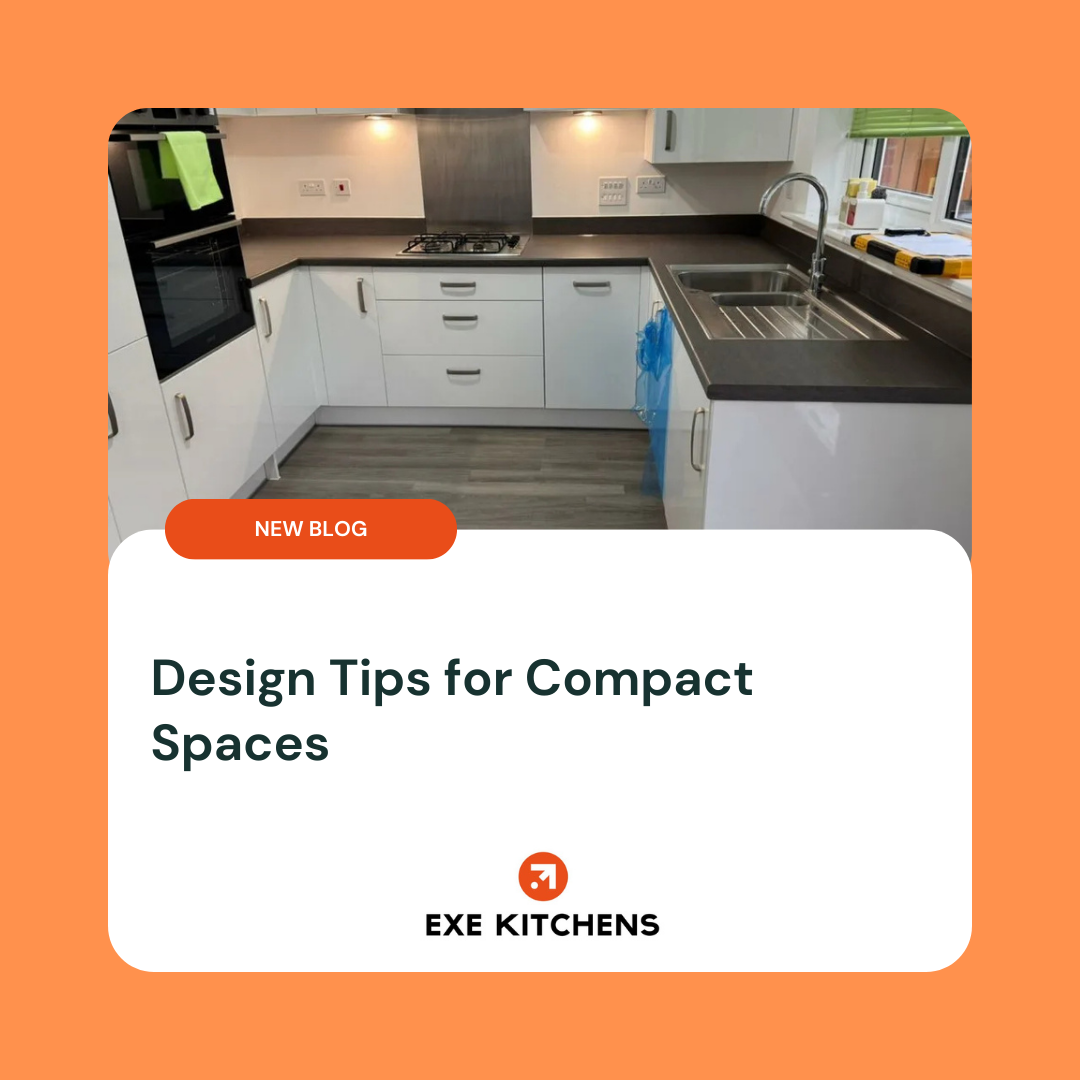Ever tried cooking in a cramped kitchen where every move feels like you’re playing an intricate game of Tetris? The challenge of lacking storage and organization can turn meal prep into an exhausting task. Yet, with smart planning and creative solutions, even the smallest kitchens can become efficient havens for culinary creativity.
In this article, we’ll dive into strategic layout designs like the L-shaped and galley kitchens that maximize functionality without wasting precious space. We’ll also explore ingenious storage ideas that ensure everything has its place—from pull-out shelves to corner cabinets—helping you enjoy your time in the kitchen rather than dreading it. Let’s start by examining some key layout strategies that bring order out of chaos.
To maximize small kitchen space, consider using vertical storage solutions such as wall-mounted shelves or cabinets to free up counter space. Additionally, incorporating multi-functional furniture, like a kitchen island with built-in storage, can greatly enhance your kitchen’s functionality while keeping it organized.

Smart Layout Planning
The design of your kitchen plays a critical role in how efficiently you can navigate it and accomplish your culinary tasks. Thoughtful layout planning ensures that every precise corner is utilized effectively, ultimately transforming even the tiniest kitchens into delightful cooking environments. When considering your kitchen’s layout, think about how you typically cook. Are you more of a straightforward chef who prefers keeping everything in a straight line? Or do you love to move around while preparing a meal? Your answers will guide you toward the most suitable design.
L-Shaped Layouts
One compelling option for small kitchens is an L-shaped layout. This design allows you to position appliances and cabinets along two adjoining walls, creating a naturally efficient workspace. Imagine standing at the stove within arm’s reach of both the refrigerator and the sink. The essential work triangle—stove, sink, and fridge—is fully optimized in this arrangement. Furthermore, this layout often leaves an open area that can accommodate a small table or an island if space permits. Having that additional surface area becomes invaluable, whether for meal prep or enjoying a casual breakfast.
However, if you find yourself short on floor space, another appealing option arises.
Galley Kitchen
A galley kitchen offers a smart solution, especially for tight spaces such as apartments or older homes. In this configuration, cabinets and appliances are placed on parallel walls, ensuring each foot of available room is put to good use without sacrificing movement functionality. This layout is particularly advantageous for those who like to cook in a linear sequence, enabling easy access to all tools and ingredients without losing time traversing around corners or obstacles.
In fact, many chefs appreciate how the galley kitchen minimizes unnecessary movements. Everything is arranged systematically; utensils hung within grasp above the counter and spices stored just steps away from the stove create fluidity in your cooking process. If you’re short on kitchen real estate, consider incorporating shelves or racks along these walls to complement the existing cabinetry for additional storage.
It’s also important to keep in mind other factors that make these layouts work effectively for your personal needs, such as traffic flow and storage solutions. As we transition further into enhancing your space, let’s now explore innovative approaches to optimize every inch of your kitchen.
Clever Storage Solutions
Proper storage is vital for a small kitchen to stay organized and clutter-free. One ingenious option involves pull-out shelves, which enhance accessibility and help prevent the dreaded “black hole” effect of lower cabinets. Imagine reaching effortlessly into your cabinet to retrieve your favorite pots without having to rummage through a pile of pans; pull-out shelves make this dream a reality. By sliding outwards, they bring everything into view, ensuring you won’t forget that beautiful roasting pan or an infrequently used baking dish hiding at the back.
Additionally, consider investing in corner cabinets equipped with specialized organizers such as Lazy Susans or pull-out shelves. These creative solutions maximize often wasted space—a common challenge when dealing with corners—allowing you to utilize every inch effectively.
Beyond these specific modifications, there are countless ways to elevate your kitchen’s storage game. For example, using magnetic knife strips can free up counter space while keeping knives safely accessible. Instead of cramming utensils into drawers where they may get lost or damaged, you can showcase them on the wall, turning functional items into an attractive display.
There are several other clever storage ideas to implement:
- Over-the-cabinet storage baskets: Perfect for pot and pan lids, these baskets hang easily over cabinet doors, keeping your most frequently used items within reach.
- Stackable shelves: This adjustment can essentially double your shelf space by creating added levels, allowing you to store more items without sacrificing available room.
- Clear containers: Store small ingredients like spices, beans, or grains in labeled clear containers for easy identification and access; it looks neat and simplifies meal prep.
The beauty of these storage solutions lies in their versatility; they can blend seamlessly into various kitchen styles while making your space both practical and inviting. Exploring additional aspects of organization can greatly enhance efficiency and create a harmonious cooking environment.
Utilizing Vertical Space
Vertical space is a hidden treasure in any small kitchen. Often, we forget about the upward areas that can be utilized for storage, but with some creativity and strategic planning, you can easily transform your kitchen’s functionality. For instance, think about utilizing the unused areas above your countertops or cabinets. By capitalizing on this space, you’re not only optimizing organization but also enhancing the overall flow of your kitchen.
Hanging Racks
Install hanging racks for pots, pans, and utensils. These racks can be mounted above the sink or stove, allowing easy access to frequently used items while preserving valuable countertop space. Imagine the simplicity of grabbing your sauté pan without rummaging through a cabinet—it’s both efficient and elegant. It’s essential to ensure the racks are securely fastened to prevent accidents during use. Keeping your pots and pans visible encourages you to utilize them more often, promoting home-cooked meals rather than resorting to takeout.
Another great option when it comes to utilizing vertical space is incorporating shelves.
Open Shelving
Open shelves can serve multiple purposes: they provide a platform for storing dishes, displaying spices in pretty jars, or showcasing decorative items like plants or cookbooks. This approach boosts not only storage but also aesthetics, as these shelves can brighten and open up the kitchen environment. The key is to maintain a harmonious look; consider using sturdy, attractive materials such as wood or metal that blend well with your existing decor.
When selecting what to place on your open shelves, think about accessibility as well as visual appeal. Arrange items based on frequency of use—everyday dishes should be lower down while beautiful serving platters can take higher positions. Moreover, mixing functional and decorative items brings character to your space without crowding it.
An aesthetically appealing shelf doesn’t just enhance the kitchen—it transforms your cooking experience into one that’s more enjoyable.
Beyond aesthetics and organization, adding artwork or framed recipes to nearby walls can create a cozy atmosphere while further maximizing that vertical space around your kitchen.
By creatively using vertical areas and incorporating features like hanging racks and open shelving systems, you can significantly boost both storage efficiency and charm within your kitchen space. Now let’s explore how thoughtfully selected appliances contribute to making the most out of limited room.
Choosing Compact Appliances
Modern technology has revolutionized kitchen design, providing us with an array of high-performance, compact appliances that fit seamlessly into even the smallest spaces. When selecting these appliances, it’s essential to focus on functionality without sacrificing quality. Opting for smaller versions of essential kitchen gadgets allows you to maintain a fully operational cooking area while maximizing available space.
Mini Refrigerators
A mini refrigerator is a fantastic addition to any small kitchen. These clever devices can fit snugly under countertops or in tight corners, offering enough storage for your essentials without overwhelming the room. The convenience of having a dedicated space for beverages and snacks cannot be understated, especially when entertaining guests or during busy mornings.
With many brands producing models that are only 22-28 inches wide yet offer 10-13 cubic feet of storage, you have plenty of options to choose from for keeping your perishables fresh while avoiding bulk.
Mini refrigerators often come equipped with energy-efficient features as well, ensuring they blend functionality with sustainability. It’s worth considering your typical food storage needs; for instance, some models arrive with designated compartments for fruits and vegetables, making them not just compact but also versatile.
Investing in a quality mini refrigerator that suits your lifestyle can transform how you work within your kitchen, providing easy access to food without taking up unnecessary room.
Multi-Functional Appliances
Another smart appliance choice is to invest in multi-functional items, which serve more than one purpose and therefore save significant amounts of space. These versatile devices effectively consolidate what might require multiple units into one efficient solution.
For example, microwave-convection oven combos are perfect; they can handle everything from reheating leftovers to baking delicious treats, all within a single unit. This dual functionality preserves valuable countertop real estate while allowing you the flexibility you need in meal preparation. Similarly, a single-unit washer-dryer combo can be a lifesaver for those living in tight quarters, effortlessly merging laundry tasks into a streamlined process.
When shopping for multi-functional appliances, look out for features that truly resonate with your cooking habits. Many devices nowadays offer programmable settings and smart technologies that enhance convenience while ensuring they remain compact. By opting for these modern appliances tailored for small spaces, you can optimize both efficiency and aesthetic appeal in your kitchen—a win-win situation!
With efficient appliances set in place, it’s time to explore strategies that embrace minimalism and organization to further enhance your culinary workspace.
Minimalist Organization Strategies

At its core, minimalist organization hinges on the concept of function folding seamlessly into form. It’s not merely about tossing things out; rather, it’s about curating a space that works for you by implementing clever strategies.
One effective method is to embrace vertical space. Tall shelving units can help keep items organized without occupying precious counter space. By utilizing every inch up to the ceiling, you create an instant sense of roominess while keeping essentials within reach.
Moreover, consider the arrangement of your items. Group similar items together — pots with pots, utensils with utensils. This creates visual harmony while also improving accessibility. For instance, placing cooking oils next to spices makes cooking flow smoother as everything needed is at arm’s length. The goal is to eliminate the unnecessary hustle when reaching for something, which can become tedious quickly in a small kitchen.
A key element of minimalist organization lies in using transparent containers or labels for visibility. Clear bins allow you to see what’s inside at a glance, ensuring that nothing sits forgotten at the back of a cupboard.
Furthermore, research emphasizes the psychological benefits of organized spaces, suggesting that decluttered environments lead to increased focus and lower stress levels. Imagine walking into your kitchen and immediately feeling calm because everything has its designated place.
Declutter Regularly
Keep in mind that regular decluttering serves as maintenance for your minimalist kitchen. It’s like going to the gym; consistency yields the best results. Schedule monthly audits where you examine each drawer and cabinet. As daunting as this may sound, it can be incredibly liberating to actively reduce clutter. You might be surprised by how many items merely occupy space or which die-hard relics you forget existed!
Implement a “one in, one out” rule while shopping: for every new item you bring into your home, let go of an old one. This simple philosophy cultivates a more intentional collection of kitchenware, ensuring you never overflow your space with items that don’t serve immediate purposes.
Essential Items Only
As you lean into this minimalist lifestyle, consider adopting a mindset comparable to maintaining a capsule wardrobe — choose only the essentials that provide maximum utility and joy. Think about versatility: can that baking dish double as a serving platter? Can the blender whip up smoothies and sauces? The key is prioritizing quality over quantity; it’s better to own fewer well-designed tools than a dizzying array of mediocre gadgets.
Just as one would refine their wardrobe to versatile pieces they love, aim to cultivate your kitchen inventory around vital pieces you use consistently. This streamlines your routine and reinforces functionality within your limited space.
With these fundamental principles guiding your approach, you’re now poised to further enhance the efficiency and appeal of your workspace by focusing on maximizing other areas within your kitchen layout.
Optimizing Wall and Counter Space

Walls and counters are indeed prime real estate in small kitchens, and utilizing these to their fullest potential is key. One innovative approach to maximizing wall space is by installing pegboards. This versatile tool allows you to hang utensils, pots, pans, and even decorative items. With hooks and shelves that can be moved around easily, you have the flexibility to customize your kitchen’s layout based on your needs or style preferences. Imagine reaching for your favorite spatula hanging right above your prep area—it’s both convenient and visually appealing.
Clear Countertops
When it comes to countertops, keeping them clear is vital for making a small kitchen feel more spacious. Cluttered countertops can overwhelm the senses and reduce functionality. Instead of leaving your coffee maker, toaster, or mixer out all the time, consider storing these appliances in cabinets or on open shelves when they’re not in use. If you do need to keep items on display for easy access, opt for a few aesthetically pleasing canisters for storing dry goods or a designated fruit bowl.
A clean countertop creates an inviting environment that encourages cooking and meal preparation.
Moreover, think about utilizing trays or tiered organizers on your countertops. They can help consolidate smaller items like spices, oils, or even baking ingredients while maintaining an organized look. This creates an impression of enough space without overcrowding the surface area. Additionally, incorporating decorative elements such as plants or art pieces can add personality while still promoting organization.
By implementing these strategies for wall and counter space, you’re paving the way toward a kitchen that feels larger and more functional. Next, we’ll explore how to illuminate this newly organized space effectively.
Effective Lighting Techniques
Good lighting can significantly impact how spacious your kitchen feels, and it’s essential to explore different techniques that can make your small area more inviting and functional. A study by the Illuminating Engineering Society found that bright, layered lighting can make small spaces feel up to 50% larger. This is where effective lighting strategies come into play, transforming your kitchen from cramped to cozy.
Under-Cabinet Lighting
One of the best ways to optimize illumination in a small kitchen is through under-cabinet lighting. It serves a dual purpose: illuminating your workspaces for chopping vegetables or reading recipes while simultaneously reducing shadows that tend to make spaces feel smaller and less welcoming. Using LED strip lights is highly recommended due to their energy efficiency and ease of installation. You don’t need an electrician; simply clean the surface beneath your cabinets and peel off the adhesive backing.
The soft glow from under-cabinet lights allows you to see what you’re doing without harsh overhead glare, creating a warm ambiance as well.
As we shift focus to maximizing light from outside sources, let’s examine another crucial element.
Natural Light
Maximizing natural light in your kitchen can dramatically enhance its spaciousness. Start by keeping windows free from heavy drapes, opting instead for light, sheer curtains which allow sunlight to filter through while maintaining a sense of privacy. Moreover, if you have the opportunity and resources, consider installing a skylight. Imagine waking up to warm sunlight flooding your kitchen—it’s a beautiful way to start the day!
Even with small adjustments such as strategically placing mirrors across from windows, you can reflect the natural light around the room to create an illusion of depth and space. By bouncing light off surfaces, you enhance brightness without relying solely on artificial sources.
Additionally, take advantage of any openings that allow sunshine in; perhaps it’s a small window above the sink or even glass cabinet doors. Open those up and let in the daylight! Not only does this brighten up your kitchen physically, but it can elevate your mood as well, making cooking an enjoyable experience.
Combining these lighting techniques creates a brighter, more inviting kitchen space that feels both spacious and functional. This sets a solid foundation for further enhancing efficiency in an otherwise compact area.
Extra Efficiency Tips for Small Kitchens
When it comes to maximizing a small kitchen, every inch counts. A well-planned layout can enhance not only your storage but also your cooking experience.
One clever strategy is to install magnetic strips on walls or the sides of your cabinets. These strips can hold knives and other metal utensils, keeping them visible and easily accessible while freeing up precious drawer space. Imagine how much time you save when reaching for the utensils you use most often without having to rummage through cluttered drawers.
As we discuss visibility and accessibility, consider investing in clear containers for pantry items.
Using clear bins or jars helps you quickly identify what you have without digging through boxes. This organizes your pantry and adds an aesthetically pleasing touch to your kitchen. You might opt to label each container so anyone using the kitchen knows exactly where everything belongs. Grouping similar items together can be a time-saver when you’re preparing meals, as you can grab everything at once rather than searching separately.
Furthermore, let’s remember that even the insides of cabinets and drawers can succumb to disarray.
Implementing drawer dividers will help you keep cooking utensils, measuring cups, and other small tools organized. By categorizing and compartmentalizing these items, you’ll create a more functional workspace. Instead of sifting through a chaotic jumble of gadgets, you’ll quickly find what you need, allowing you to maintain focus while cooking.
Each season brings unique culinary demands, so let’s make room for some seasonal organization.
Rotate your seasonal cookware and ingredients by placing less-used items in harder-to-reach spots as the season changes. For example, during summer months, keep grilling tools and lighter cooking surfaces easily accessible while stowing away heavier pots used in winter months behind those accessible items. This way your workspace stays tidy and adaptable throughout the year.
Implementing these practical strategies ensures that your kitchen remains not just functional but also a joyful place where cooking becomes less of a chore and more of a delightful experience.
Incorporating these smart solutions will transform any small kitchen into an efficient work area that encourages creativity and joy in cooking. Maximum efficiency isn’t just about saving space; it’s about enhancing your overall culinary journey.
What design tips can help make a small kitchen feel larger?
To make a small kitchen feel larger, utilize light colors for cabinetry and walls to reflect more light, creating an illusion of space; studies indicate that lighter shades can enhance perceived room size by up to 20%. Incorporate open shelving instead of bulky cabinets to maintain visual openness, and use mirrors strategically to double the visual space. Additionally, opting for multi-functional furniture, such as a kitchen island with built-in storage, can minimize clutter while maximizing utility, effectively transforming the area into a more spacious environment.
What are some creative storage solutions for small kitchens?
Creative storage solutions for small kitchens include utilizing vertical space with wall-mounted shelves and pegboards, which can increase storage by over 30% in some cases. Additionally, magnetic strips for knives and spice jars can free up counter space while keeping essentials within reach. Incorporating multi-functional furniture, such as rolling carts that serve as both prep areas and extra storage, can maximize efficiency. Lastly, under-shelf baskets are an excellent way to use the often-overlooked space beneath existing shelves to keep items organized and easily accessible.
Are there specific furniture or fixtures that optimize space in a tiny kitchen?
Yes, specific furniture and fixtures can significantly optimize space in a tiny kitchen. Multi-functional furniture, such as an island with built-in storage or collapsible tables, can enhance usability without sacrificing area. Additionally, vertical storage solutions like wall-mounted shelves and magnetic strips for utensils effectively utilize unused vertical space. According to a study by the National Kitchen & Bath Association, well-organized kitchens can improve efficiency by up to 30%, making these smart choices essential for maximizing tiny kitchen layouts.
How can I arrange appliances to save space in a compact kitchen?
To save space in a compact kitchen, arrange appliances by prioritizing countertop real estate; consider stacking and utilizing vertical storage solutions, like wall-mounted shelves or multi-tiered stands for smaller devices. Place frequently used appliances at eye level to minimize movement and maximize efficiency, while lesser-used items can be stored in cabinets or on higher shelves. According to the National Kitchen & Bath Association, effective space planning can improve kitchen functionality by up to 30%, making it easier to navigate your compact kitchen.
How can lighting affect the perception of space in a small kitchen?
Lighting plays a crucial role in the perception of space in a small kitchen by enhancing visibility and creating an illusion of openness. Bright, well-distributed lighting can make the area feel larger and more welcoming, while darker spaces can appear cramped and uninviting. According to studies, good lighting can increase the perceived size of a room by up to 20%, making strategic use of task and ambient lighting essential for maximizing small kitchen space. By incorporating under-cabinet lights, pendant fixtures, or even reflective surfaces, homeowners can dramatically improve their kitchen’s atmosphere and functionality.


